

![]()
0 Comment
Customer Reviews (0)Export business is pivotal in a country's economic growth and stability. It offers numerous advantages, including job creation, foreign exchange earnings, economic diversification, and global market exposure.
Success in the export business, however, is not guaranteed. It requires a well-thought-out business plan considering market research, logistics, regulatory compliance, and financial management. We offer comprehensive and customizable export business plan templates to assist entrepreneurs in this endeavor.
The business plan ppt templates provide a structured framework for outlining your business goals, strategies, and financial projections, ensuring a smooth path to export success. With the right plan and these templates, you can capitalize on the immense opportunities the global market offers and contribute to your country's economic global market development.
Our business plan template bundles are crafted with precision, keeping in mind all of the nitty-gritty of the export business. These templates use the best graphics to ensure your business idea shines through. When you download this business plan template, you will get access to a 65-page template document. These are completely editable as per your needs and requirements. However, for the ease of this blog, we will only highlight the top 10 templates from this entire deck.
This is the initial section of your export business plan, serving as a concise roadmap for the reader. It should encapsulate the essential aspects of your export strategy, including identifying target markets, primary objectives, a summary of key strategies, and a brief overview of financial projections and timelines. This summary sets the stage for the entire plan, looking at what the audience can expect to find in more detail further in the document.
In our Executive Summary section, you will get templates for
1.1 The Quick Pitch: A concise and compelling overview of your export business, capturing its essence and potential in a few sentences.
1.2 The Entity: Describing your business's legal structure and core identity, ensuring clarity regarding its nature and organization for international trade .
1.3 Company Overview: Offering a comprehensive introduction to your cross-border commerce , including its history, mission, and the core values that drive your international endeavors.
1.4 Products and Services: Detailing the range of export products and services you offer, emphasizing their unique features and how they meet the needs of international customers.
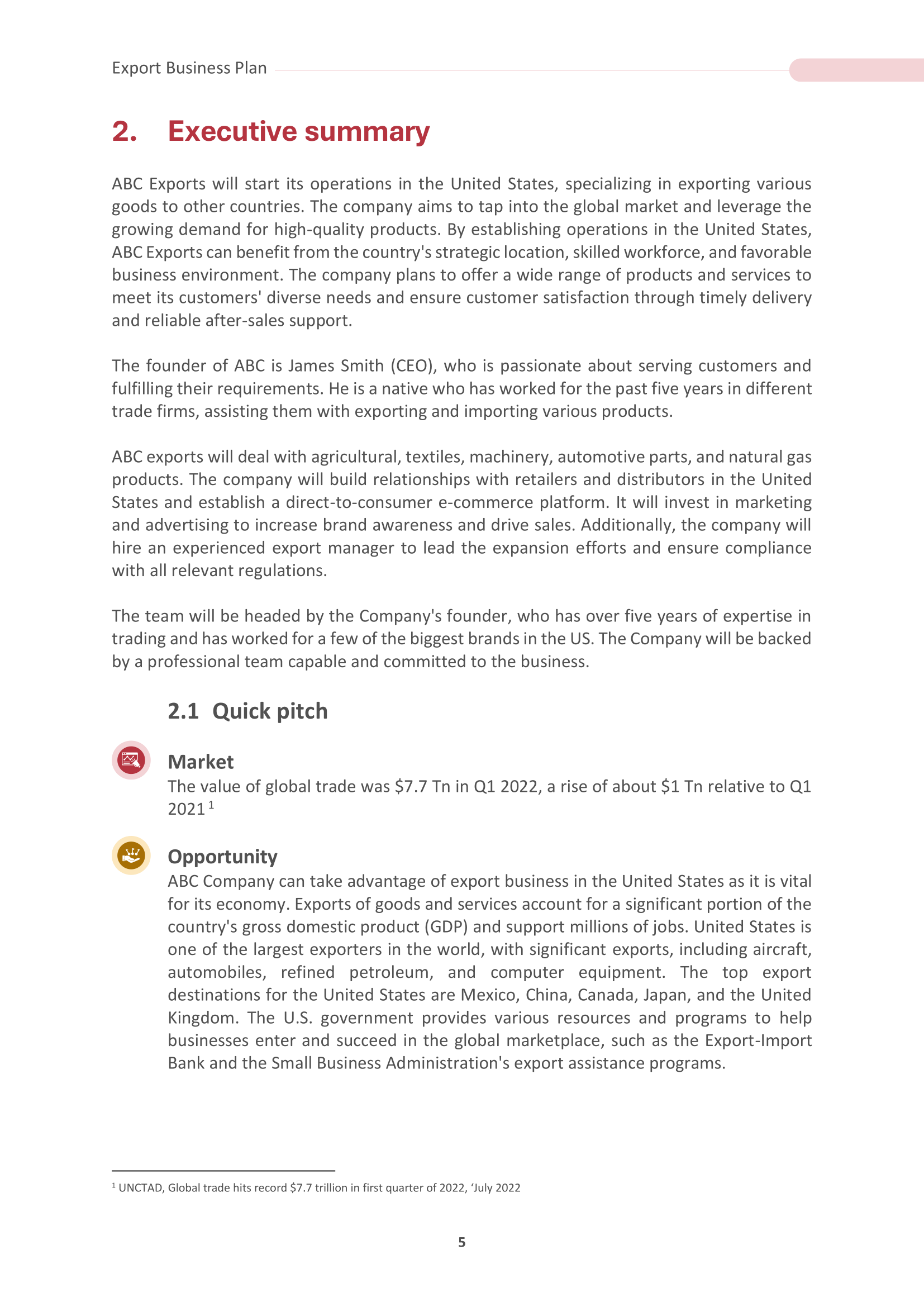
(Do you have a trading business and wish to scale it up? We have a suitable template for a multinational trading business plan; you can download it here )
The company overview delves into the core aspects of your business. It provides information about your company's history, experience in international trade, certifications (such as ISO standards or export-related qualifications), and financial stability. This section aims to build confidence in your company's ability to operate successfully in the export market, demonstrating your credibility as an export partner.
In our Company Overview section, you will get templates for
2.1 Mission and Vision: Your export business's overarching purpose and long-term aspirations define your commitment to international success.
2.2 Goals and Objectives: The specific targets and milestones that steer your import-export business towards accomplishment in global markets.
2.3 Start-up Summary: A concise outline of the initial financial and operational aspects required to launch and establish your export operations.
2.4 Market Gap and Solution: Identifying a void in international markets and how your products or services provide a solution, ensuring a clear value proposition.
2.5 Product and Services Offered: Detailing the range of products and services of your export business offers, emphasizing their uniqueness and relevance in global markets.
2.6 Key Success Factors: The critical elements that underpin your export business's success, serving as the foundation for sustainable growth in foreign trade .
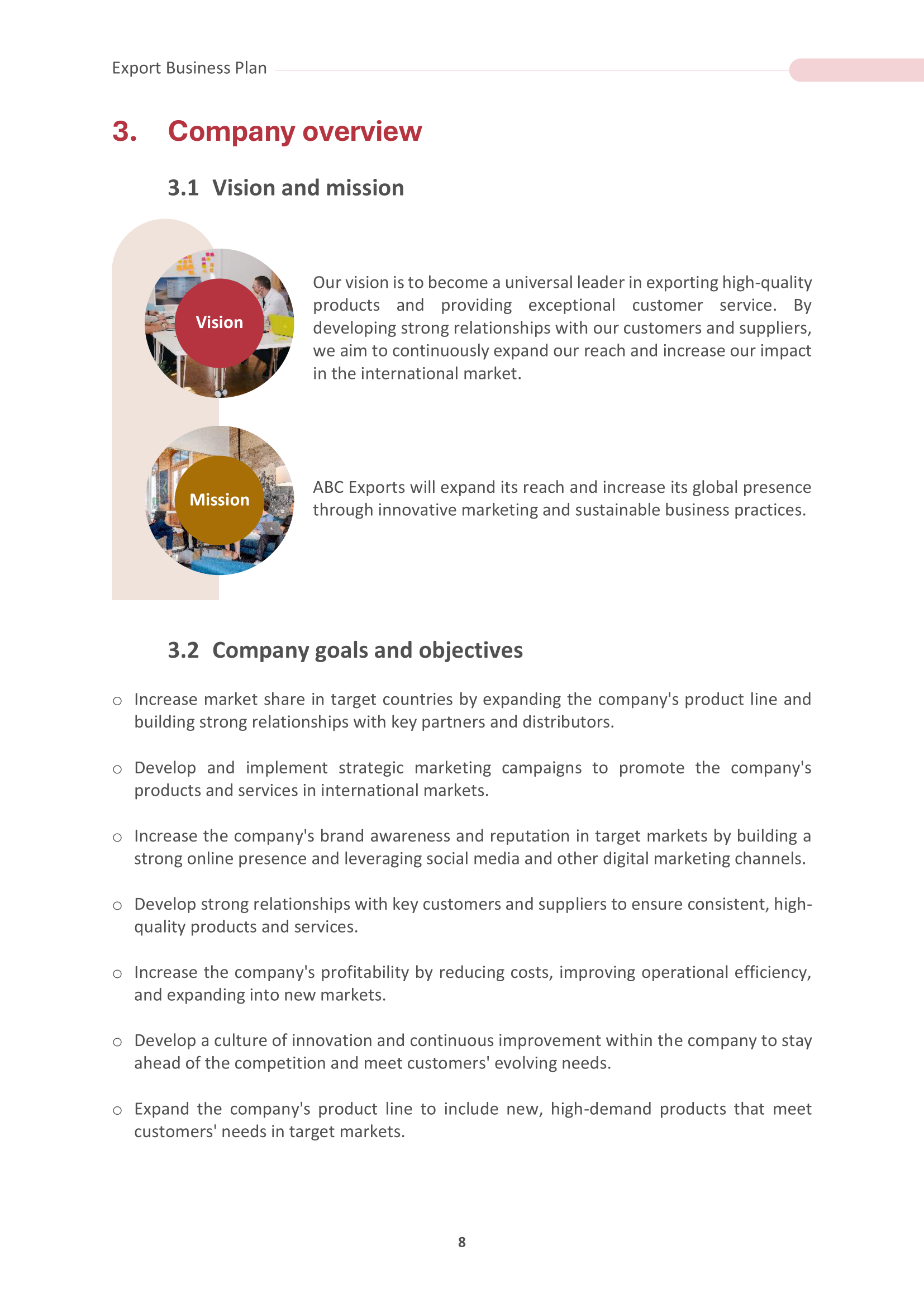
(Looking for something more generic that caters to international business ? Well, you are in luck! We have a business plan template that caters to international business !)
The industry analysis explores the global market where you intend to export your products or services. It should examine market trends, regulatory environments, and trade policies affecting your industry. This analysis helps you identify potential growth areas, challenges, and opportunities that can improve your import strategy.
In our Industry Analysis section, you will get templates for
3.1 Market Analysis: A comprehensive examination of international markets to identify opportunities and assess the export potential of your products.
3.2 Market Trends: Tracking global trade dynamics and consumer behavior shifts ensures your export strategies align with current and future market trends.
3.3 Major Challenges: Identifying the key hurdles and obstacles your export business may encounter in international markets and formulating strategies to overcome them.
3.4 Growth Drivers: Recognizing the factors that stimulate expansion and success in global markets, leveraging them to propel your export venture forward.
3.5 Geographical Analysis: Examining specific regions and countries to determine the most promising export destinations, tailoring your approach to each market's unique demands and opportunities.
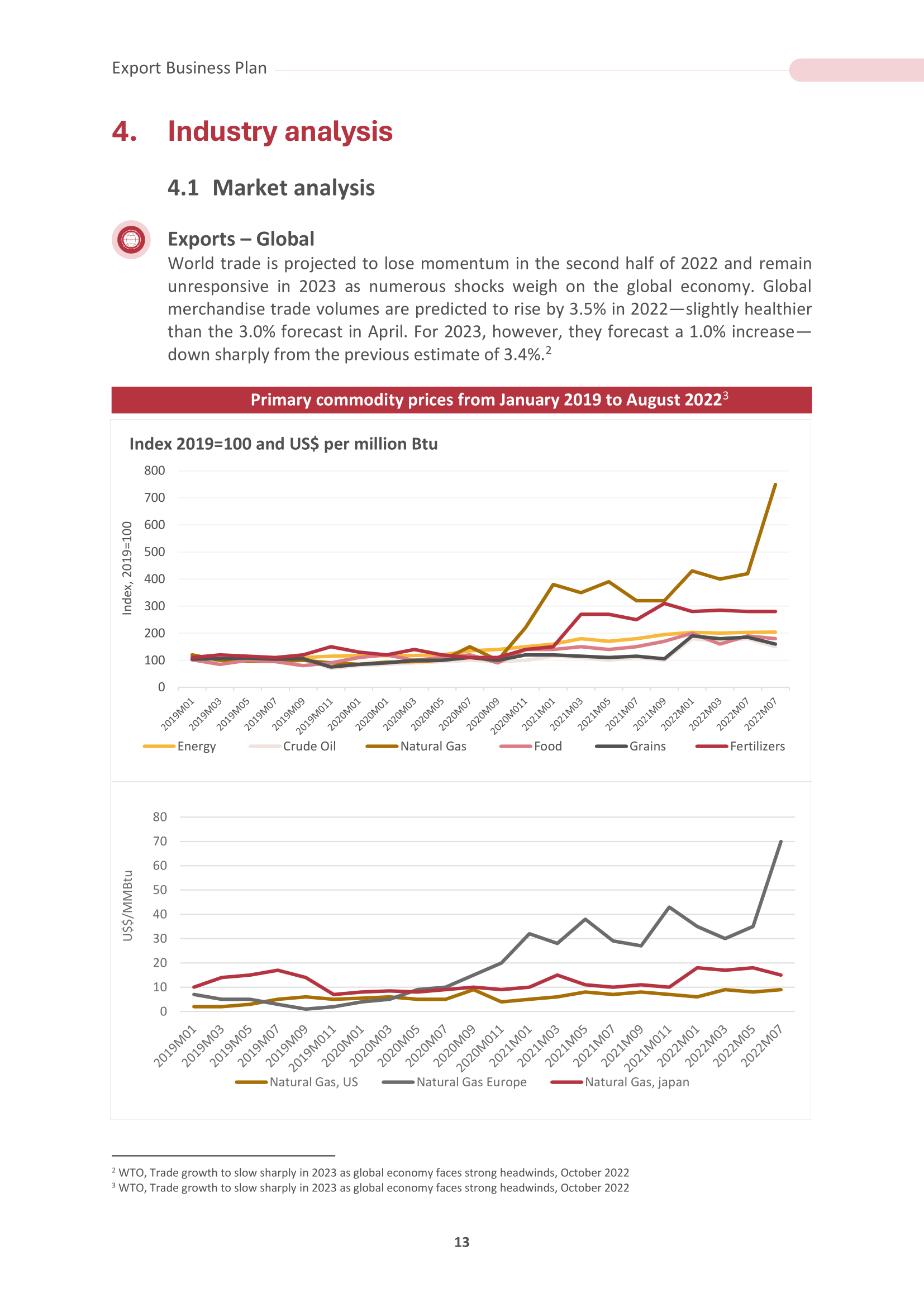
(Is your business strategy driven? You need a template that focuses on the target market and global expansion. Get the best of both through this template )
In the customer analysis section, you must define and understand your target international customers. This involves delving into their demographics, preferences, behaviors, and cultural factors that may impact their purchasing decisions. A thorough customer analysis will guide you in tailoring your products, services, and marketing approaches to align with the needs and expectations of your global clientele.
In our Customer Analysis section, we offer comprehensive templates for:
4.1 Target Market: Defining the specific countries or regions where your export business aims to sell products, narrowing down the global focus.
4.2 Buyer Persona: Creating a detailed profile of the ideal international customer, understanding their needs and preferences to tailor export strategies better.
4.3 Market Sizing: Assessing the potential of the export market by determining its size in terms of customers, demand, and revenue, providing a clear understanding of the export opportunity.
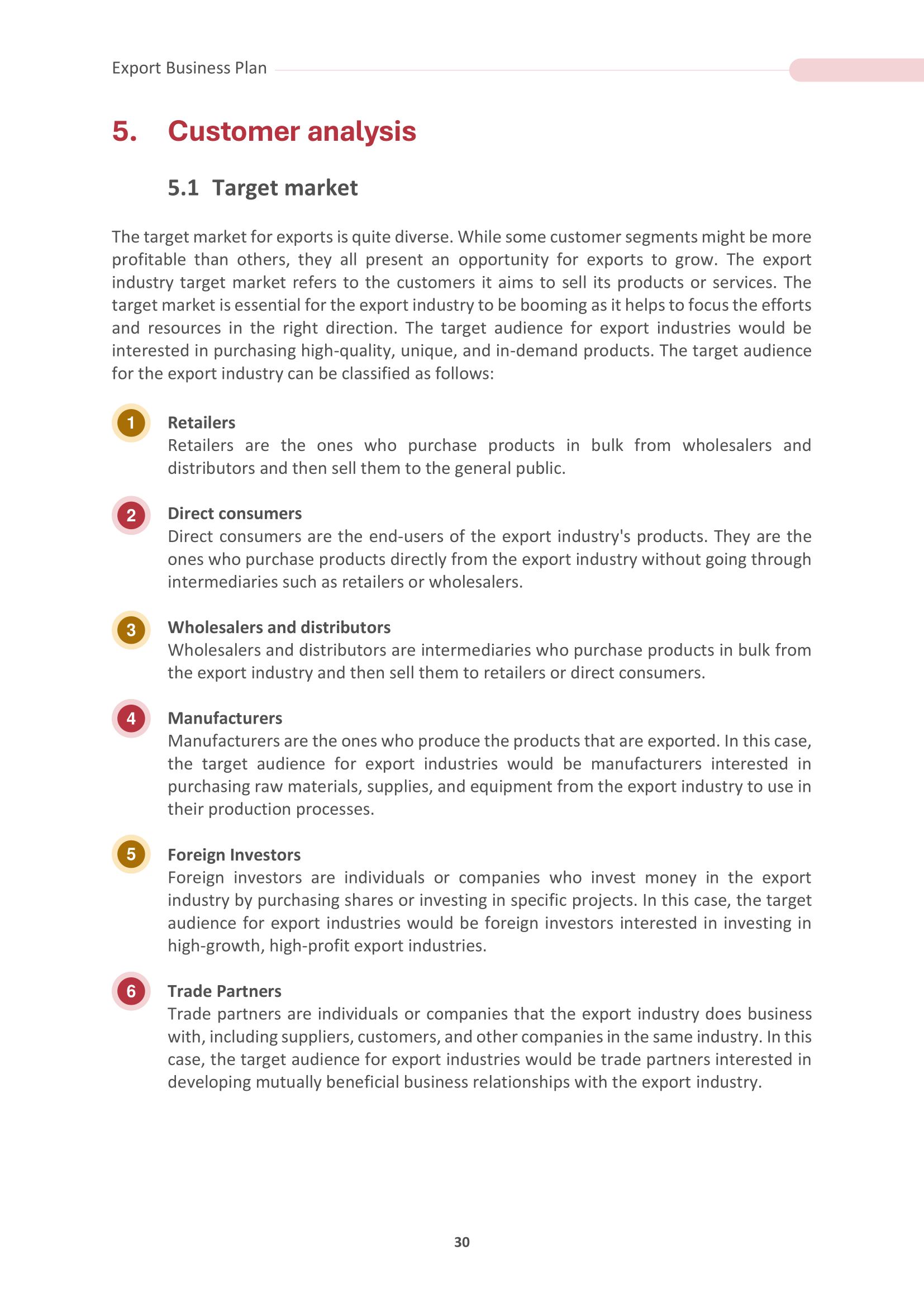
Analyzing the competitive landscape in your target markets is crucial for developing effective export strategies. This section should identify key competitors in the international market, evaluate their strengths and weaknesses, and provide insights into their market share. Understanding the competitive dynamics will help you position your products or services effectively and gain a competitive advantage.
In our Competitive Landscape section, we provide templates for:
5.1 Major Players: Identifying and analyzing key competitors and influential entities in the international market who impact your business.
5.2 Attributes Comparison: Evaluate the specific characteristics and features of your export products or services compared to those offered by competitors to determine your unique selling points and competitive advantages.
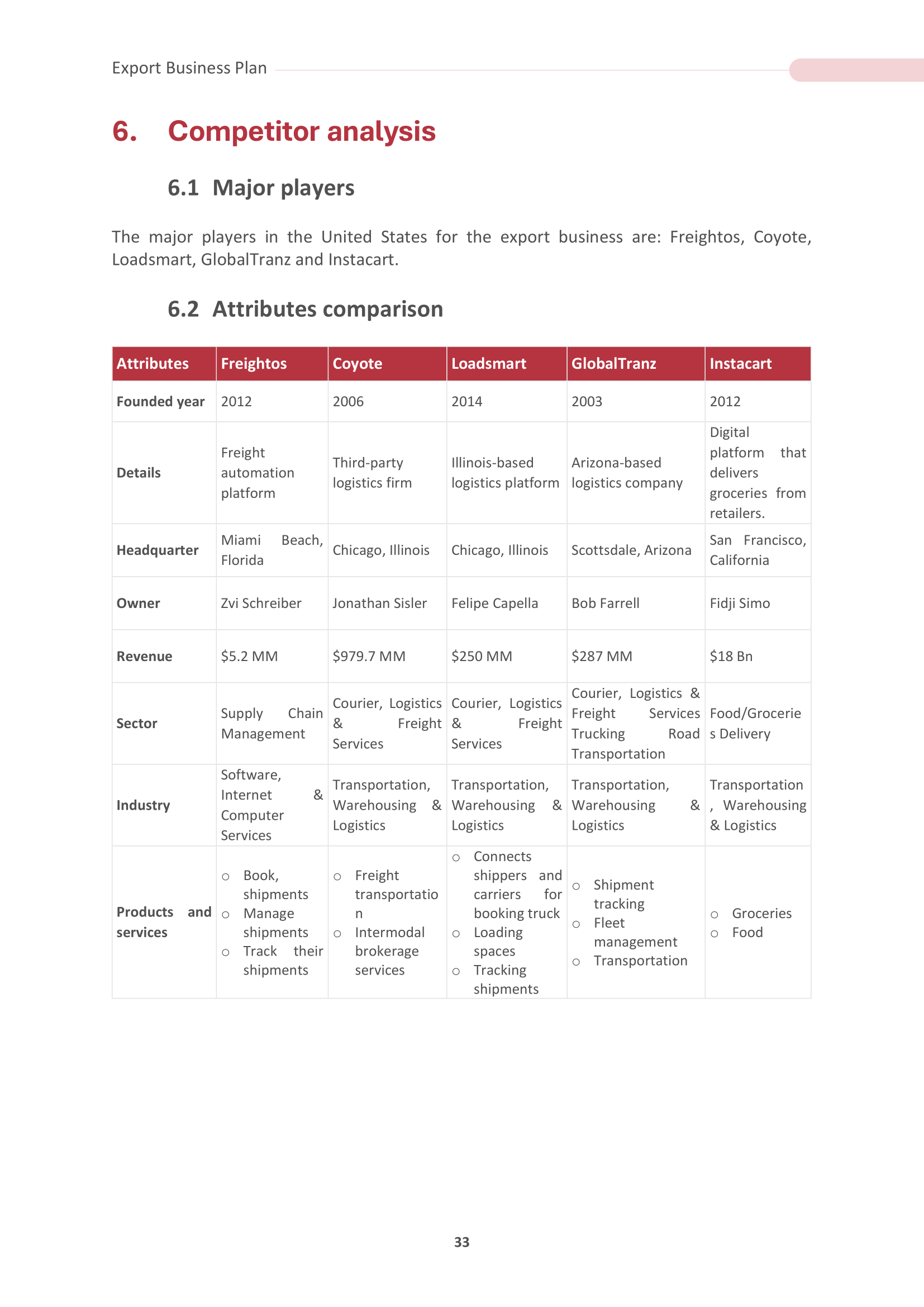
A SWOT analysis is considered to be a strategic tool that assesses your export venture's internal strengths and weaknesses, also external opportunities and threats. This analysis provides a holistic perspective of your business and the export environment. By identifying internal advantages and challenges and external market opportunities and threats, you can make informed decisions, create mitigation plans, and better position your company for international success.
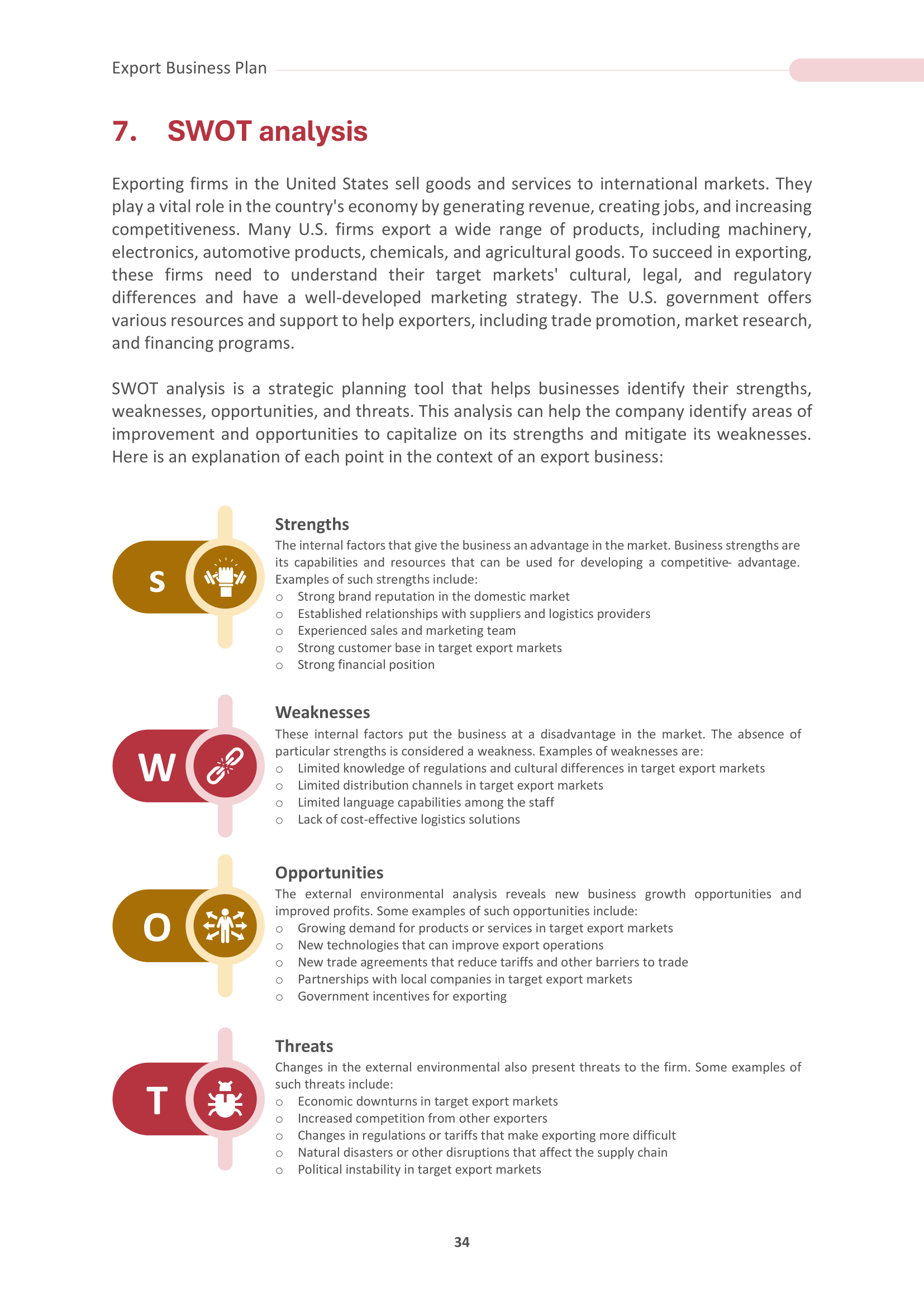
Porter's Five Forces framework is considered an excellent tool for analyzing the competitive forces within your industry. It examines the power of suppliers, the bargaining of buyers, the threat of new brands and substitutes, and the intensity of competitive rivalry. This analysis helps you understand the competitive dynamics of the export market, identify potential challenges, and develop strategies to address them effectively. You can make informed decisions about market entry and competition mitigation strategies using Porter's framework.
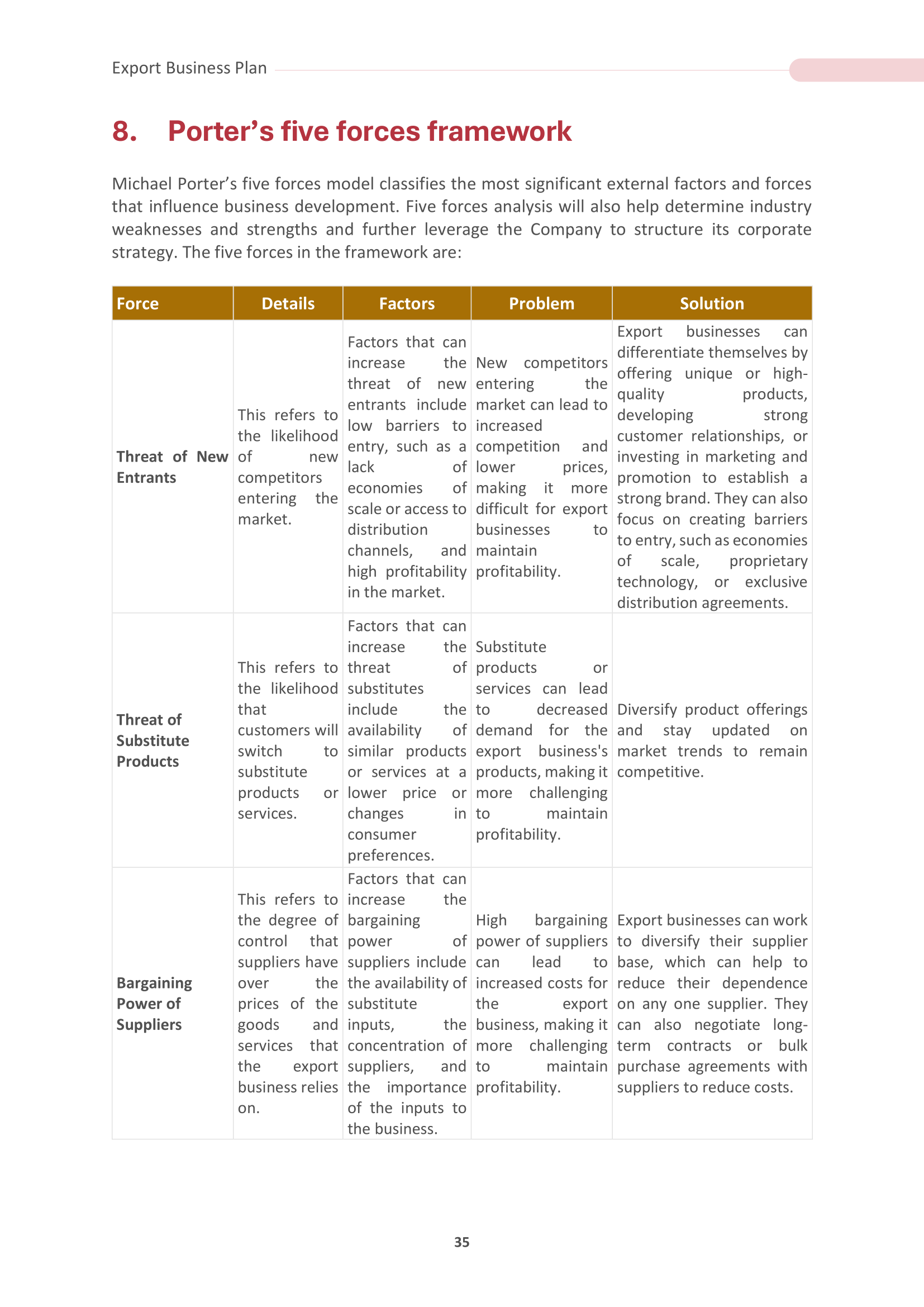
The marketing plan in an export business outlines the strategies for promoting and selling your products or services in international markets. It should include details about your international marketing mix, pricing strategies, distribution channels, and promotional efforts. A robust marketing plan is essential for gaining market share and building brand recognition in your target export markets.
In our Marketing Plan section, we provide templates for:
8.1 Sales and Distribution Strategy: Outlining the plan for leveraging international sales and distribution platforms to enhance brand visibility and engage with international customers in the export market.
8.2 Promotional Strategy: A comprehensive plan designed to increase brand visibility, engage international audiences, and drive sales in the global export market.
8.3 Pricing Strategy: Defining the approach for setting competitive and profitable prices for your export products or services, considering international market dynamics and customer expectations.
8.4 Sales Funnel: Describing the step-by-step process that international customers go through, from initial awareness to purchasing, facilitating efficient lead conversion in your export business.
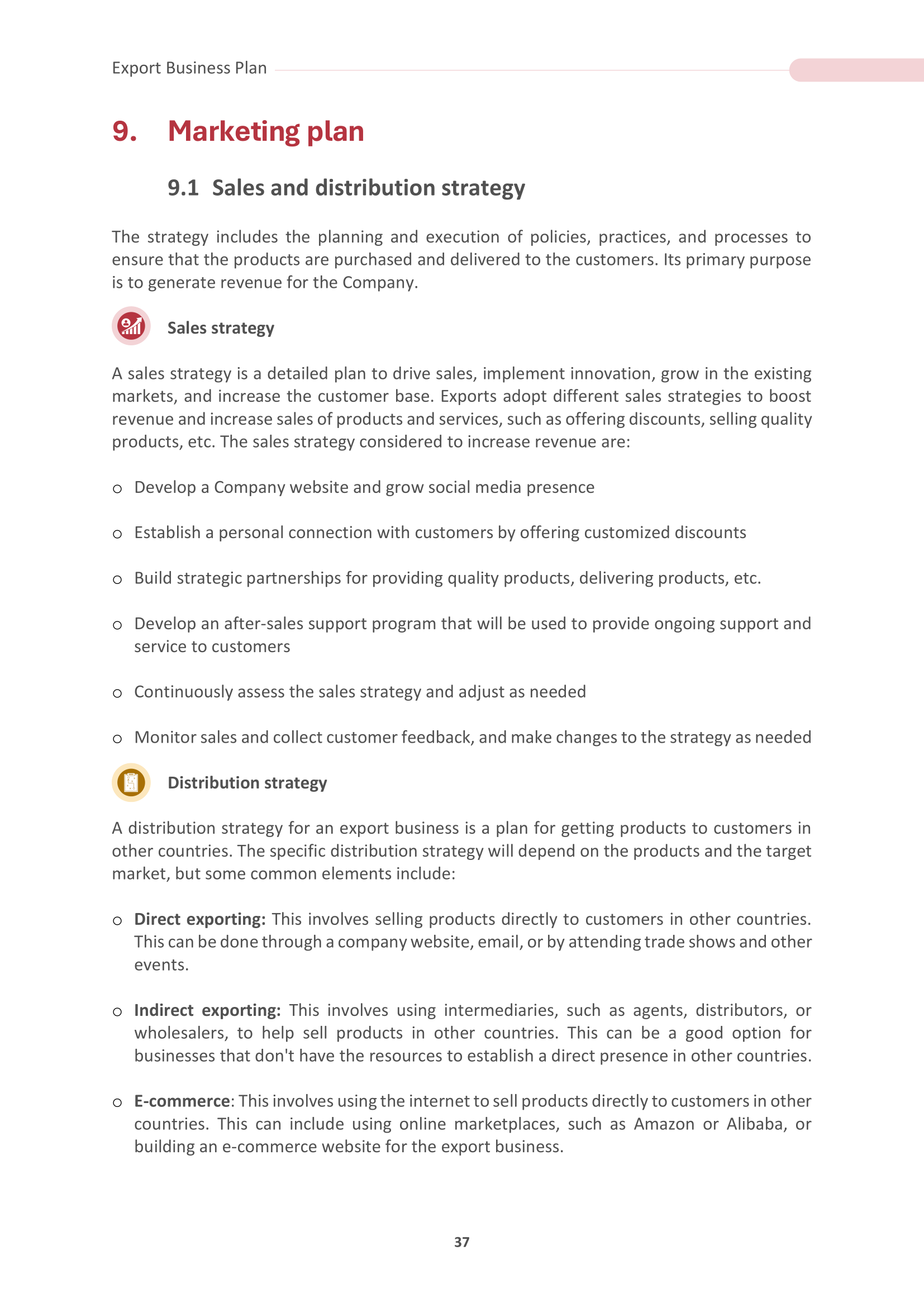
The operational plan defines how your company will execute its export strategy. This section should cover logistics, production, supply chain management, quality control, and international regulations and standards compliance. It's essential to provide a clear and organized operational plan to ensure a smooth flow of goods or services to your international customers.
In our Operational Plan section, we provide templates for:
9.1 Business Model: The blueprint of your export enterprise, elucidating how you create, deliver, and capture value in international markets, ensuring a clear understanding of your global trade approach.
9.2 Goals to be achieved: The specific, measurable objectives guiding your export business, ensuring a defined path to international success and a framework for tracking your progress.
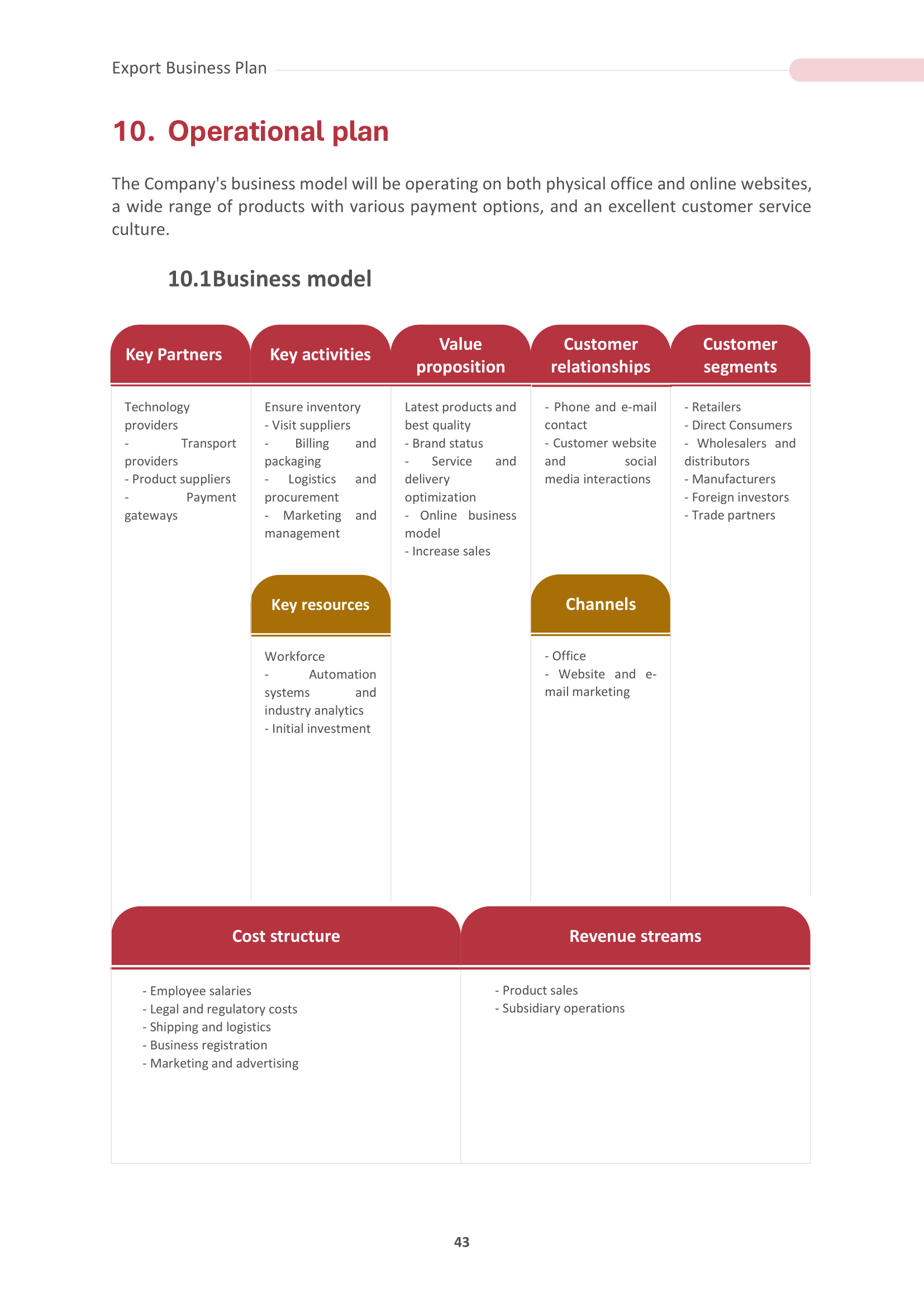
The financial plan is a critical section of the export business plan, detailing the expected costs, revenue projections, and financial forecasts related to your international expansion. It should include budgets, cash flow statements, break-even analysis, and return on investment calculations. This information helps stakeholders, including investors and lenders, understand your export business's financial viability and sustainability.
In our Financial Plan section, we provide templates for:
10.1 Financial Assumptions: Highlighting the critical assumptions underpinning the export venture's financial projections.
10.2 Revenue Model and Sales Forecast: Defining the approach for generating revenue from international markets and providing a sales forecast for export operations.
10.3 Break-Even Analysis: Identifying the point at which export revenues cover costs, indicating when the business becomes profitable.
10.4 Projected Profit and Loss Account: Summarizing expected revenues, expenses, and profitability for the export business over a specified period.
10.5 Projected Cash Flow Statement: Outlining the expected cash inflows and outflows related to export activities, ensuring cash liquidity for international operations.
10.6 Projected Balance Sheet: Present a snapshot of the export business's financial position, including assets, liabilities, and equity, specific to international trade.
10.7 Scenario Analysis: Assessing various scenarios to understand the impact of various elements on the financial performance of the export business.
10.8 DCF Valuation: Applying the Discounted Cash Flow process to determine the present value of future cash flows, assisting in the valuation of the export business in the international market.
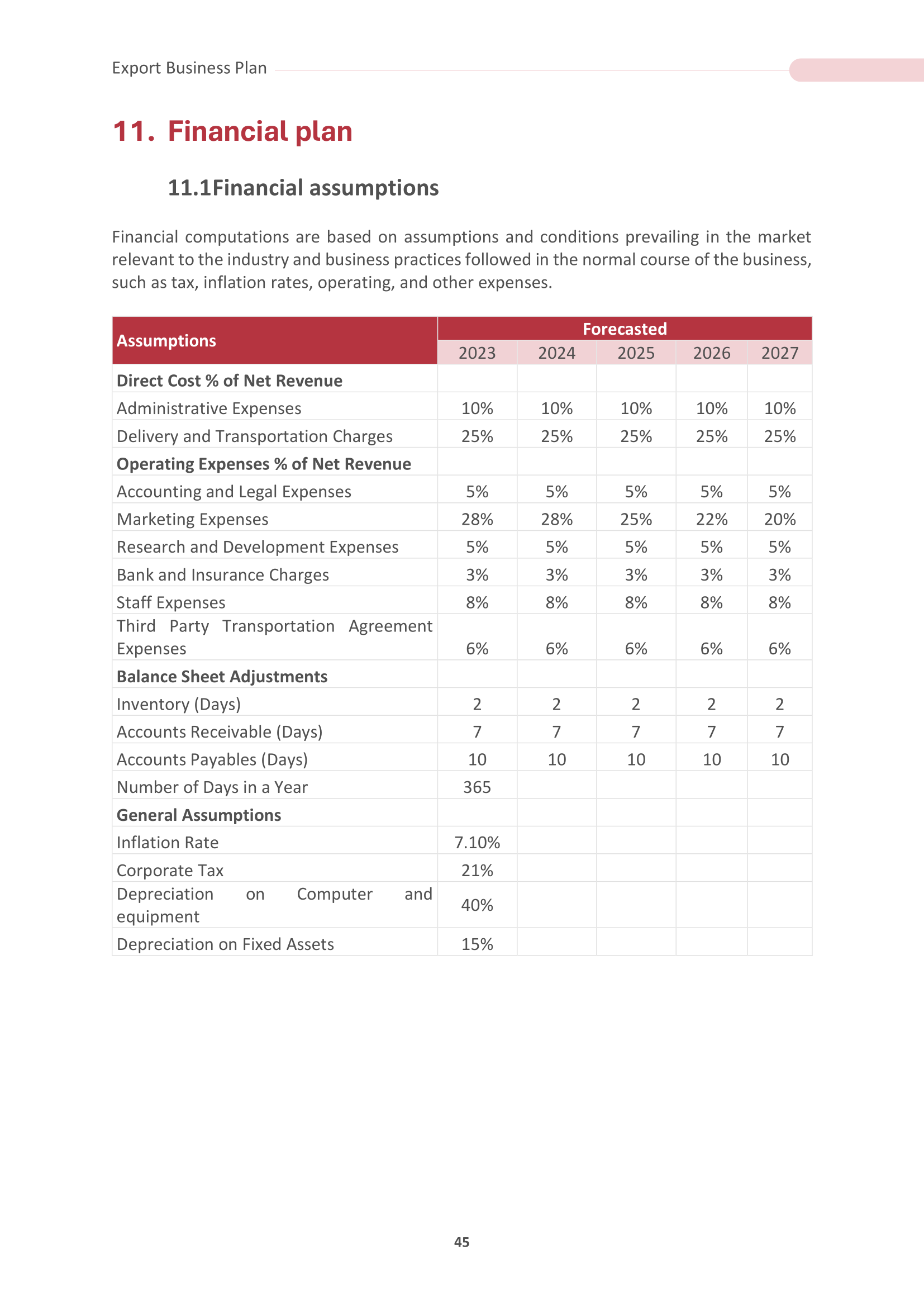
An export business plan considers many elements, and we know you are the expert to manage it all! However, we can only help you with the best base to get started. By downloading these templates, you are not only creating the right start for your business, but also creating a lasting impression for your investors. This 65-pager template deck has everything you will need for your business; what more can you ask for? For easy access and editability, you can download the PowerPoint file of this deck from here ! Happy business planning.